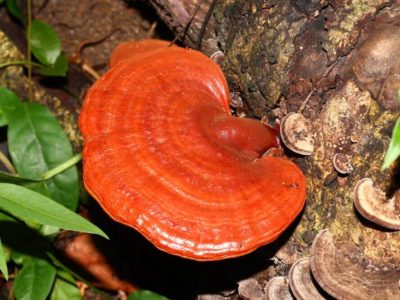Table of Contents[Hide][Show]
Learn about the different types of fungi and the fungi health benefits so you can appreciate mushrooms more here!
Welcome to the Fungi Kingdom
There are many types of fungi in the world. One study said there are about 5.1 million species of fungi based on sequencing methods!
There’s a good chance humans have not identified all of them. You don’t hear much about fungi, however, due to some misconceptions, which you will learn later on.
Not learning more about fungi can be a missed opportunity because they do have some health benefits. To begin your journey into the fungi kingdom, we’re going to talk about the following:
- Definition of fungi
- Kinds of fungi
- Characteristics of fungi
- Fungi examples and differences
What Are Fungi?
Fungi are cellular organisms that are also eukaryotes, which means the nucleus is within a membrane. This definition separates the types of fungi from bacteria.
A bacterial cell is a prokaryote, which means the organelles don’t have a membrane. Their cellular structure is also less complex than that of the prokaryote.
Related
9 Best Vegan Probiotics For Gut Health
If you do not consume dairy, here are some vegan probiotic foods that are are fantastic when it comes to taking care of your gut health.
Some of the common examples of fungi are the following:
- Mold spores
- Yeast
- Mushroom and toadstools, which are fungi that look like mushrooms
There are also five phyla that make up the fungi kingdom. They are:
- Phylum Basidiomycota, where mushrooms belong
- Phylum Glomeromycota, which creates a symbiotic relationship with plants (plants provide fungi nutrients while the fungi increase water and nutrients of plants)
- Phylum Zygomycota, which can grow on decaying matter and human food sources (e.g., bread mold)
- Phylum Ascomycota, which can be pathogenic and cause disease (e.g., skin infections like ringworm and jock itch, nail bed infection, and yeast infection or Candida albicans)
- Phylum Chytridiomycota, which is microscopic, aquatic, and harmful to harlequin frogs
Characteristics of Fungi
Here are the known fungi characteristics:
- All fungi are eukaryotes, but most fungi are multicellular organisms. They are similar to plants, animals, and humans in this sense.
- They reproduce through spores, which the air or wind can carry to different regions. They can remain dormant until they are within the right environmental exposure.
- They tend to grow in a warm or moist environment. In other words, one of their requirements is water.
- They can produce fruiting bodies such as mushrooms when the growth conditions are right.
- Not all of them are edible fungi, with at least 70 species of them classified as poisonous. Some may be poisonous at certain stages such as mushroom puffballs.
- The different types of fungi are heterotrophs, which means they cannot reproduce their own food. This forces them to build relationships with other organisms in their surroundings.
How Fungi Get Their Food
For the fungi cell to work, it needs nutrients. Fungi get them with the help of their hyphae, which are filaments that can branch out quickly.
When there are already many hyphae, they can form a network called mycelium. It’s the mycelium that will be on the lookout for food, especially decomposing or decaying organic matter.
Sometimes, it can become parasitic, such as when it starts to consume plants and even animals. That’s why some plants may have traces of fungicide, a chemical used to kill fungi in plants.
Some types of fungi can also anchor themselves into their food source or area where the fruiting body grows. Scientists call this the substrate.
Human-Fungi Relationships
Now that we’ve covered the basics of the types of fungi and their characteristics, let’s focus on an interesting relationship: human and fungi.
We Come from Mushrooms
Say what? Yes, that’s according to Tero Isokauppila, an expert in the world of all things mushroom.
Tero is from Finland and grew up on the organic family farm that’s in its thirteenth generation. He said that about 10 years ago, scientists figured out we actually come from mushrooms, not plants.
About 1.3 billion years ago, mushrooms came from the sea. They were the first things to come to dry land. These mushrooms were living beings eating rocks and creating soil.
We, as humans, are part of the same superkingdom because they breathe oxygen like we do and expel carbon dioxide (CO2).
Most cultures originally were mushroom-friendly, but then some cultures got freaked out by them and turned away from using them.
Like the North Americans, who are kind of behind the mushroom trends compared to the Orientals and the Europeans. Why? They were afraid of fungal diseases.
As mentioned, there are wild mushrooms that are bad news and can kill us. Some fungi can also lead to human illness, bad reactions, or symptoms.
These can include mold allergies and asthma. Individuals with weakened immune systems or gut issues are more likely to experience these problems.
There are many varieties of mushrooms, however, that are full of great qualities making them super beneficial to us.
Fungi Benefits to Health
Mushrooms can fall into a couple of different categories, and we’ve covered most of them above. You can also group them as the medicinal kind and the culinary kind.
The edible mushrooms have great nutritional value. They are a good source of vitamin D as well as potassium, magnesium, selenium, phosphorus, calcium, and iron. They are also rich in b vitamins such as riboflavin, niacin, folate, and pantothenic acid. These b vitamins are essential in red blood cell production and transport of oxygen throughout the body. Mushrooms are abundant in beta glucans as well, which boost the immune system.
Mushrooms also contain a lot of dietary fiber and they can replace animal protein as a source of carbohydrates. If you’re looking to start a weight loss diet, it should definitely include mushrooms.
You can easily add a serving of mushrooms to a meal as they make for great additions to most foods such as soup, pasta, pizza, burgers, and more! Sauteed mushrooms are especially tasty.
Medicinal mushrooms tend to grow on trees and have amazing health benefits, including antibacterial and anti-inflammatory properties.
Of the many mushroom health benefits, one of the more surprising is that studies have shown they can prevent heart disease by helping to lower blood pressure and cholesterol levels. They can also boost brain function and may even help protect from serious neurodegenerative diseases such as Alzheimer’s or Parkinson’s.
In fact, 40% of all pharmaceuticals use fungi, Tero pointed out. It’s not even all new-age stuff.
Related
8 Medicinal Mushrooms You Need To Know About
Learn about eight popular medicinal mushrooms, how they are beneficial to health, and a few ways you can incorporate them into your diet.
Ever Heard of Chaga?
Have you ever heard of penicillin? Yeah, we all have. It comes from mushrooms.
How about chaga? This type of mushroom has one of the highest sources of antioxidants in the world and can help lower inflammation.
It doesn’t look like a typical mushroom. It almost looks like tree bark, but you drink it in a tea.
This little guy works wonders on colon health and can help support the immune system.
Everyone likes to talk about the other herbs when they have a cold or flu. What mushrooms can do is help people who are sick by slowing down the inflammation (the source of most illness and disease).
And check this out: the Food and Drug Administration (FDA) considers most mushrooms as food that is generally regarded as safe.
That’s right – Mushrooms aren’t supplements. However, due to the strong taste and texture, many mushroom products are sold in capsules or powders.
And there’s more; some mushrooms can be used as uppers, or natural energizers (without caffeine). Cordyceps mushrooms are a fantastic example.
On the other end of the spectrum, Reishi mushrooms are the opposite of energizing. They can have a calming effect on the body.
For people who have sleep issues, the reishi mushroom can be of great benefit. This mushroom helps support the glands and the endocrine system, but in a very calming, grounding way.
Other helpful and/or delicious mushrooms are:
- Morels
- Shiitake
- Chanterelle
- Cremini
- Maitake
- Portobello
- Enoki
- Truffles
The common white button mushrooms are a good addition to many recipes since they have such a mild flavor and are rich in vitamin D (33% daily value).
Enough Fungi to Go Around
One of the latest discoveries is a type of mushroom in the Amazon called Aspergillus tubingensis, and do you know the coolest thing about it?
It destroys and eats plastic. Can you believe it! A part of nature that’s helping to keep plastic away from nature.
Tero says we can help the environment by planting mushrooms like this in specific locations to let them do amazing things. There are lots of problems going on in this world, and mushrooms just might be the answer to them.
Final Thoughts
These lessons about the different types of fungi teach us one thing. Even tiny organisms can do wonders in this world.
They can keep you healthy (as long as your gut is also in shape), and they may even help preserve the planet.
Take them with your probiotic and super greens, so you can take your health to a higher and better level.
You May Also Like…
Editor’s Note: This article was originally published on September 21, 2016, and has been updated on December 1, 2021 for quality and relevancy.






